The Use of Ashes in Surface Metal Matrix Composites Produced by Friction Stir Processing
Abstract
:1. Introduction
2. Materials and Methods
3. Methodology of Composite Production
4. Results and Discussion
4.1. Microscopic Examinations
4.2. Hardness Measurement
4.3. Wear Resistance Tests
5. Conclusions
Author Contributions
Funding
Institutional Review Board Statement
Informed Consent Statement
Data Availability Statement
Conflicts of Interest
References
- Chen, R.; Wang, H.; Li, J.; He, B.; Shao, W.; Zhang, S. Effect of laser remelting and heat treatment on microstructure and wear resistance of 2A97 Al-Li alloy. Surf. Interfaces 2022, 33, 102197. [Google Scholar] [CrossRef]
- Benedetti, A.; Cabeza, M.; Castro, G.; Feijoo, I.; Mosquera, R.; Merino, P. Surface modification of 7075-T6 aluminium alloy by laser melting. Surf. Interface Anal. 2012, 44, 977–981. [Google Scholar] [CrossRef]
- Luo, G.; Xiao, H.; Li, S.; Wang, C.; Zhu, Q.; Song, L. Quasi-continuous-wave laser surface melting of aluminium alloy: Precipitate morphology, solute segregation and corrosion resistance. Corros. Sci. 2019, 152, 109–119. [Google Scholar] [CrossRef]
- Mishra, R.S.; Mahoney, M.W. Friction stir processing: A new grain refinement technique to achieve high strain rate superplasticity in commercial alloys. Mater. Sci. Forum 2001, 357–359, 507–514. [Google Scholar] [CrossRef]
- Mishra, R.S.; Ma, Z.Y. Friction stir welding and processing. Mater. Sci. Eng. R Rep. 2005, 50, 1–78. [Google Scholar] [CrossRef]
- Thomas, W.M.; Nicholas, E.D.; Needham, J.C.; Murch, M.G.; Templesmith, P.; Dawes, C.J. International Patent Application. No. PCT/GB92/02203 and GB Patent Application No. 9125978.8, December 1991. [Google Scholar]
- Ahmed, M.M.Z.; El-Sayed Seleman, M.M.; Fydrych, D.; Çam, G. Friction Stir Welding of aluminum in the aerospace industry: The current progress and state-of-the-art review. Materials 2023, 16, 2971. [Google Scholar] [CrossRef] [PubMed]
- Kosturek, R.; Torzewski, J.; Joska, Z.; Wachowski, M.; Śnieżek, L. The influence of tool rotation speed on the low-cycle fatigue behavior of AA2519-T62 friction stir welded butt joints. Eng. Fail. Anal. 2022, 142, 106756. [Google Scholar] [CrossRef]
- Khalaf, H.I.; Al-Sabur, R.; Demiral, M.; Tomków, J.; Łabanowski, J.; Abdullah, M.E.; Derazkola, H.A. The effects of pin profile on HDPE thermomechanical phenomena during FSW. Polymers 2022, 14, 4632. [Google Scholar] [CrossRef] [PubMed]
- Janeczek, A.; Tomków, J.; Fydrych, D. The influence of tool shape and process parameters on the mechanical properties of aw-3004 aluminium alloy friction stir welded joints. Materials 2021, 14, 3244. [Google Scholar] [CrossRef] [PubMed]
- Kosturek, R.; Torzewski, J.; Wachowski, M.; Śnieżek, L. Effect of welding parameters on mechanical properties and microstructure of friction stir welded AA7075-T651 aluminum alloy butt joints. Materials 2022, 15, 5950. [Google Scholar] [CrossRef] [PubMed]
- Nasiri, Z.; Sarkari Khorrami, M.; Mirzadeh, H.; Emamy, M. Enhanced mechanical properties of as-cast Mg-Al-Ca magnesium alloys by friction stir processing. Mater. Lett. 2021, 296, 129880. [Google Scholar] [CrossRef]
- Patel, V.; Li, W.Y.; Andersson, J.; Li, N. Enhancing grain refinement and corrosion behavior in AZ31B magnesium alloy via stationary shoulder friction stir processing. J. Mater. Res. Technol. 2022, 17, 3150–3156. [Google Scholar] [CrossRef]
- Iwaszko, J.; Kudła, K. Microstructure, hardness, and wear resistance of AZ91 magnesium alloy produced by friction stir processing with air-cooling. Int. J. Adv. Manuf. Technol. 2021, 116, 1309–1323. [Google Scholar] [CrossRef]
- Asl, H.G.; Celik-Uzuner, S.; Uzuner, U.; Sert, Y.; Küçükömeroğlu, T. The effect of friction stir process on the mechanical, tribological, and biocompatibility properties of AZ31B magnesium alloy as a biomaterial: A pilot study. Proc. Inst. Mech. Eng. H J. Eng. Med. 2022, 236, 1720–1731. [Google Scholar]
- Iwaszko, J.; Kudła, K. Evolution of Microstructure and properties of air-cooled friction-stir-processed 7075 aluminum alloy. Materials 2022, 15, 2633. [Google Scholar] [CrossRef]
- Meng, X.; Huang, Y.; Cao, J.; Shen, J.; dos Santos, J.F. Recent progress on control strategies for inherent issues in friction stir welding. Prog. Mater. Sci. 2021, 115, 100706. [Google Scholar] [CrossRef]
- Choudhary, A.K.; Jain, R. Fundamentals of friction stir welding, its application, and advancements. In Welding Technology; Springer Nature: Cham, Switzerland, 2021; pp. 41–90. [Google Scholar]
- Mishra, R.S.; Ma, Z.Y.; Charit, I. Friction stir processing: A novel technique for fabrication of surface composite. Mater. Sci. Eng. A 2003, 341, 307–310. [Google Scholar] [CrossRef]
- Mirzadeh, H. Surface metal-matrix composites based on AZ91 magnesium alloy via friction stir processing: A review. Int. J. Miner. Metall. Mater. 2023, 30, 1278–1296. [Google Scholar] [CrossRef]
- Sudhakar, M.; Srinivasa, C.H.; Rao, K.; Saheb, M. Production of surface composites by friction stir processing. A review. Mater. Today Proc. 2018, 5, 929–935. [Google Scholar] [CrossRef]
- Wu, B.; Ibrahim, M.Z.; Raja, S.; Yusof, F.; Abdul Razak, B.B.; Bin Muhamad, M.R.; Huang, R.; Zhang, Y.; Badruddin, I.A.; Hussien, M.; et al. The influence of reinforcement particles friction stir processing on microstructure, mechanical properties, tribological and corrosion behaviors: A review. J. Mater. Res. Technol. 2022, 20, 1940–1975. [Google Scholar] [CrossRef]
- Teo, G.S.; Liew, K.W.; Kok, C.K. A study on friction stir processing parameters of recycled AA 6063/TiO2 surface composites for better tribological performance. Metals 2022, 12, 973. [Google Scholar] [CrossRef]
- Sharma, V.; Tripathi, P. Approaches to measure volume fraction of surface composites fabricated by friction stir processing: A review. Measurement 2022, 193, 110941. [Google Scholar] [CrossRef]
- Heidarzadeh, A.; Taghizadeh, B.; Mohammadzadeh, A. In-situ formation of Zn oxide particles in CuZn matrix during friction stir processing. J. Adhes. Sci. Technol. 2021, 35, 1006–1013. [Google Scholar] [CrossRef]
- Bagheri, B.; Abbasi, M. Development of AZ91/SiC surface composite by FSP: Effect of vibration and process parameters on microstructure and mechanical characteristics. Adv. Manuf. 2020, 8, 82–96. [Google Scholar] [CrossRef]
- Velmurugan, T.; Subramanian, R.; Suganya Priyadharshini, G.; Raghu, R. Experimental investigation of microstructure, mechanical and wear characteristics of Cu-Ni/ZrC composites synthesized through friction stir processing. Arch. Metall. Mater. 2020, 65, 565–574. [Google Scholar] [CrossRef]
- Sanusi, K.O.; Akinlabi, E.T. Experimental investigation of magnesium alloy processed by friction stir process using stainless steel powder as matrix composite. Mater. Today Proc. 2018, 5, 18468–18474. [Google Scholar] [CrossRef]
- Heidarzadeha, A.; Pouraliakbarb, H.; Mahdavic, S.; Jandaghi, M.R. Ceramic nanoparticles addition in pure copper plate: FSP approach, microstructure evolution and texture study using EBSD. Ceram. Int. 2018, 44, 3128–3133. [Google Scholar] [CrossRef]
- Pol, N.; Verma, G.; Pandey, R.P.; Shanmugasundaram, T. Fabrication of AA7005/TiB2-B4C surface composite by friction stir processing: Evaluation of ballistic behavior. Def. Technol. 2019, 15, 363–368. [Google Scholar] [CrossRef]
- Wang, T.; Gwalani, B.; Shukla, S.; Frank, M.; Mishra, R.S. Development of in situ composites via reactive friction stir processing of Ti-B4C system. Compos. B Eng. 2019, 172, 54–60. [Google Scholar] [CrossRef]
- Liang, J.; Li, H.; Qi, L.; Tian, W.; Li, X.; Chao, X.; Wei, J. Fabrication and mechanical properties of CNTs/Mg composites prepared by combining friction stir processing and ultrasonic assisted extrusion. J. Alloys Compd. 2017, 728, 282–288. [Google Scholar] [CrossRef]
- Huang, Y.; Wang, T.; Guo, W.; Wan, L.; Lv, S. Microstructure and surface mechanical property of AZ31 Mg/SiCp surface composite fabricated by Direct Friction Stir Processing. Mater. Des. 2014, 59, 274–278. [Google Scholar] [CrossRef]
- Almazrouee, A.I.; Al-Fadhalah, K.J.; Alhajeri, S.N. A new approach to direct friction stir processing for fabricating surface composites. Crystals 2021, 11, 638. [Google Scholar] [CrossRef]
- Iwaszko, J.; Kudła, K.; Fila, K. Technological aspects of friction stir processing of AlZn5.5MgCu aluminum alloy. Bull. Pol. Acad. Sci. Tech. Sci. 2018, 66, 713–719. [Google Scholar]
- Ayvaz, S.I.; Arslan, D.; Ayvaz, M. Investigation of mechanical and tribological behavior of SiC and B4C reinforced Al-Zn-Mg-Si-Cu alloy matrix surface composites fabricated via friction stir processing. Mater. Today Commun. 2022, 31, 103419. [Google Scholar] [CrossRef]
- Bharti, S.; Ghetiya, N.D.; Patel, K.M.; Dutta, V. Investigating the influence of singlepass and double-pass friction stir processing on mechanical and wear behaviour of AA5083/Al2O3 surface. IOP Conf. Ser. Mater. Sci. Eng. 2021, 1136, 012071. [Google Scholar] [CrossRef]
- Abbass, M.K.; Baheer, N.A. Effect of SiC particles on microstructure and wear behavior of AA6061-T6 aluminum alloy surface composite fabricated by friction stir processing. IOP Conf. Ser. Mater. Sci. Eng. 2020, 671, 012159. [Google Scholar] [CrossRef]
- Dinaharan, I.; Akinlabi, E.T. Low cost metal matrix composites based on aluminum, magnesium and copper reinforced with fly ash prepared using friction stir processing. Compos. Commun. 2018, 9, 22–26. [Google Scholar] [CrossRef]
- Patil, N.A.; Zhongyan, N.; Pedapati, S.R.; Mamat, O.B. Investigation on effect of fly ash volume percentage on microstructure and microhardness of AA7075-fly ash surface composites via FSP. In Advances in Manufacturing Engineering: Selected Articles from ICMMPE; Springer: Singapore, 2020; pp. 399–410. [Google Scholar]
- Kumar, H.; Prasad, R.; Kumar, P.; Tewari, S.P.; Singh, J.K. Mechanical and tribological characterization of industrial wastes reinforced aluminum alloy composites fabricated via friction stir processing. J. Alloys Compd. 2020, 831, 154832. [Google Scholar] [CrossRef]
- Dinaharan, I.; Kalaiselvan, K.; Murugan, N. Influence of rice husk ash particles on microstructure and tensile behavior of AA6061 aluminum matrix composites produced using friction stir processing. Compos. Commun. 2017, 3, 42–46. [Google Scholar] [CrossRef]
- Kolli, M.; Dasari, S.N.; Potluri, N.S.; Ramprasad, A.V.S. Influence of rock dust reinforcement on mechanical properties of Al composite using friction stir processing. Aust. J. Mech. Eng. 2023, 21, 329–338. [Google Scholar] [CrossRef]
- Srivastava, A.K.; Dwivedi, S.; Nag, A.; Kumar, D.; Dixit, A.R.; Hloch, S. Microstructural, mechanical and tribological performance of a magnesium alloy AZ31B/Si3N4/eggshell surface composite produced by solid-state multi-pass friction stir processing. Mater. Chem. Phys. 2023, 301, 127694. [Google Scholar] [CrossRef]
- Patil, N.A.; Pedapati, S.R.; Mamat, O.B.; Lubis, A.M.H.S. Effect of SiC/Fly ash reinforcement on surface properties of aluminum 7075 hybrid composites. Coatings 2020, 10, 541. [Google Scholar] [CrossRef]
- Prakasam, S.; Kannakumar, K.; Mohanraj, D.; Karthi, M.; Sakthi, S.; Nanthakumar, S. Investigation on the metallurgical and welding characteristics of AA7075/Fly ash composites. Mater. Today Proc. 2024; in press. [Google Scholar] [CrossRef]
- Tyagi, L.; Butola, R.; Jha, A.K. Mechanical and tribological properties of AA7075-T6 metal matrix composite reinforced with ceramic particles and aloevera ash via friction stir processing. Mater. Res. Express 2020, 7, 066526. [Google Scholar] [CrossRef]
- Gałczyński, T.; Luty, G. Technologie łączenia struktur lotniczych; część 2; Zgrzewanie tarciowe liniowe z przemieszaniem (FSW-Friction Stir Welding). Proj. Konstr. Inż. 2018, 11, 134. [Google Scholar]
- Xie, Y.; Meng, X.; Li, Y.; Mao, D.; Wan, L.; Huang, Y. Insight into ultra-refined grains of aluminum matrix composites via deformation-driven metallurgy. Compos. Commun. 2021, 26, 100776. [Google Scholar] [CrossRef]
- Xie, Y.; Meng, X.; Chang, Y.; Mao, D.; Yang, Y.; Xu, Y.; Wan, L.; Huang, Y. Ameliorating strength-ductility efficiency of graphene nanoplatelet-reinforced aluminum composites via deformation-driven metallurgy. Compos. Sci. Technol. 2022, 219, 109225. [Google Scholar] [CrossRef]
- Adiga, K.; Herbert, M.A.; Rao, S.S.; Shettigar, A. Applications of reinforcement particles in the fabrication of aluminium metal matrix composites by friction stir processing—A review. Manuf. Rev. 2022, 9, 26. [Google Scholar] [CrossRef]
- Iwaszko, J. New Trends in Friction Stir Processing: Rapid Cooling—A Review. Trans. Indian Inst. Met. 2022, 75, 1681–1693. [Google Scholar] [CrossRef]
- Taha, A.S.; Hammad, F.H. Application of the Hall-Petch relation to microhardness measurements on Al, Cu, Al-MD 105, and Al-Cu alloys. Phys. Status Solidi A 1990, 119, 455–462. [Google Scholar] [CrossRef]
- Thangaraju, S.; Heilmaier, M.; Murty, B.S.; Vadlamani, S.S. On the estimation of true Hall-Petch constants and their role on the superposition law exponent in Al alloys. Adv. Eng. Mater. 2012, 14, 892–897. [Google Scholar] [CrossRef]
- Iwaszko, J.; Kudła, K. Effect of friction stir processing (FSP) on microstructure and hardness of AlMg10/SiC composite. Bull. Pol. Acad. Sci. Tech. Sci. 2019, 67, 185–192. [Google Scholar] [CrossRef]
- International Standard ISO 683-17; Heat-Treated Steels, Alloy Steels and Free-Cutting Steels—Part 17: Ball and Roller Bearing Steels. ISO: Geneva, Switzerland, 2014.
- Archard, J.F. Contact and rubbing of flat surface. J. Appl. Phys. 1953, 24, 981–988. [Google Scholar] [CrossRef]


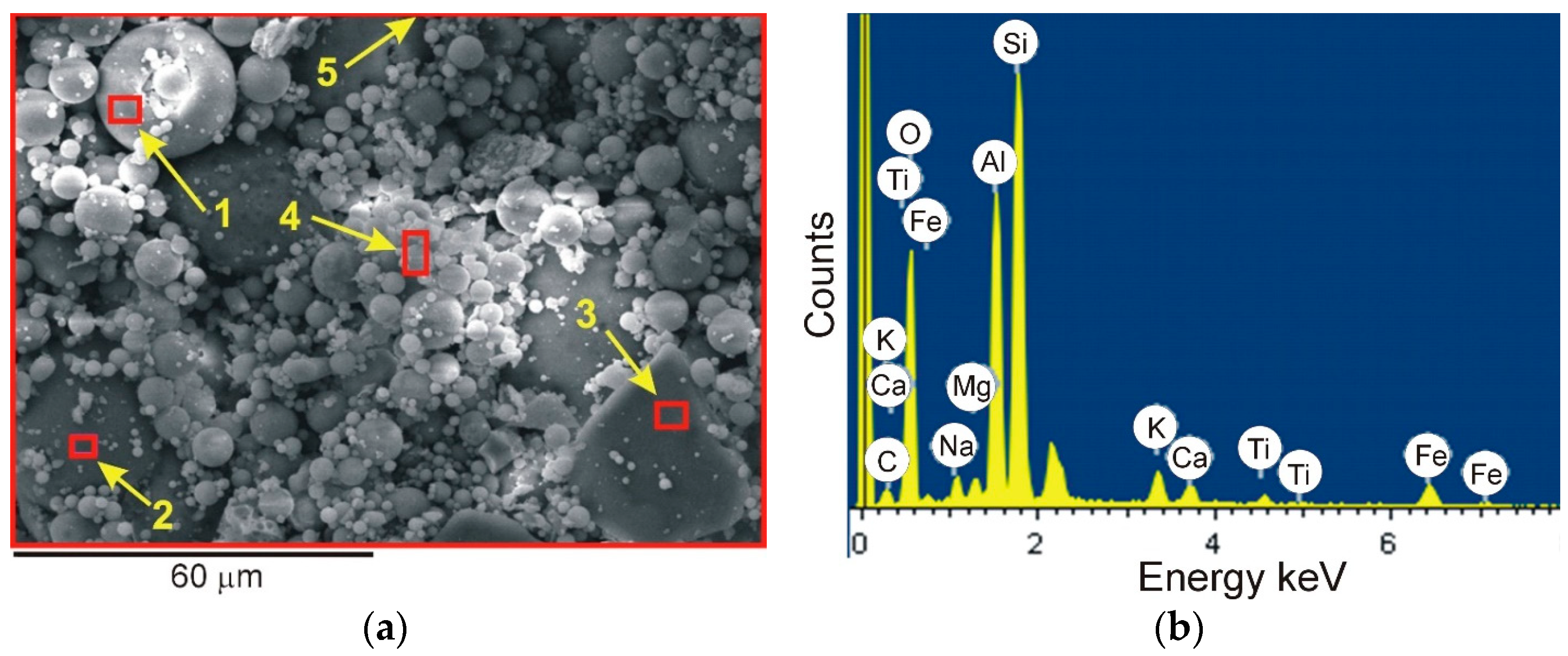
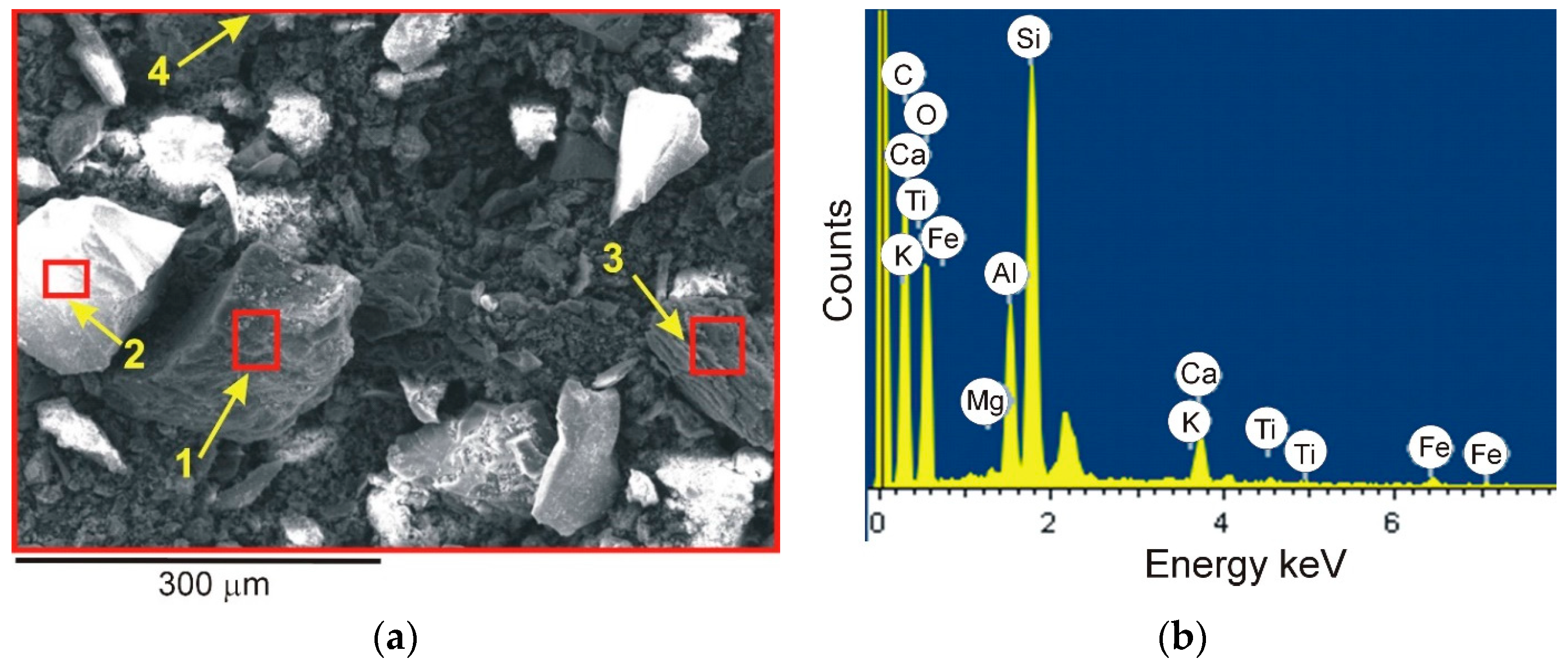

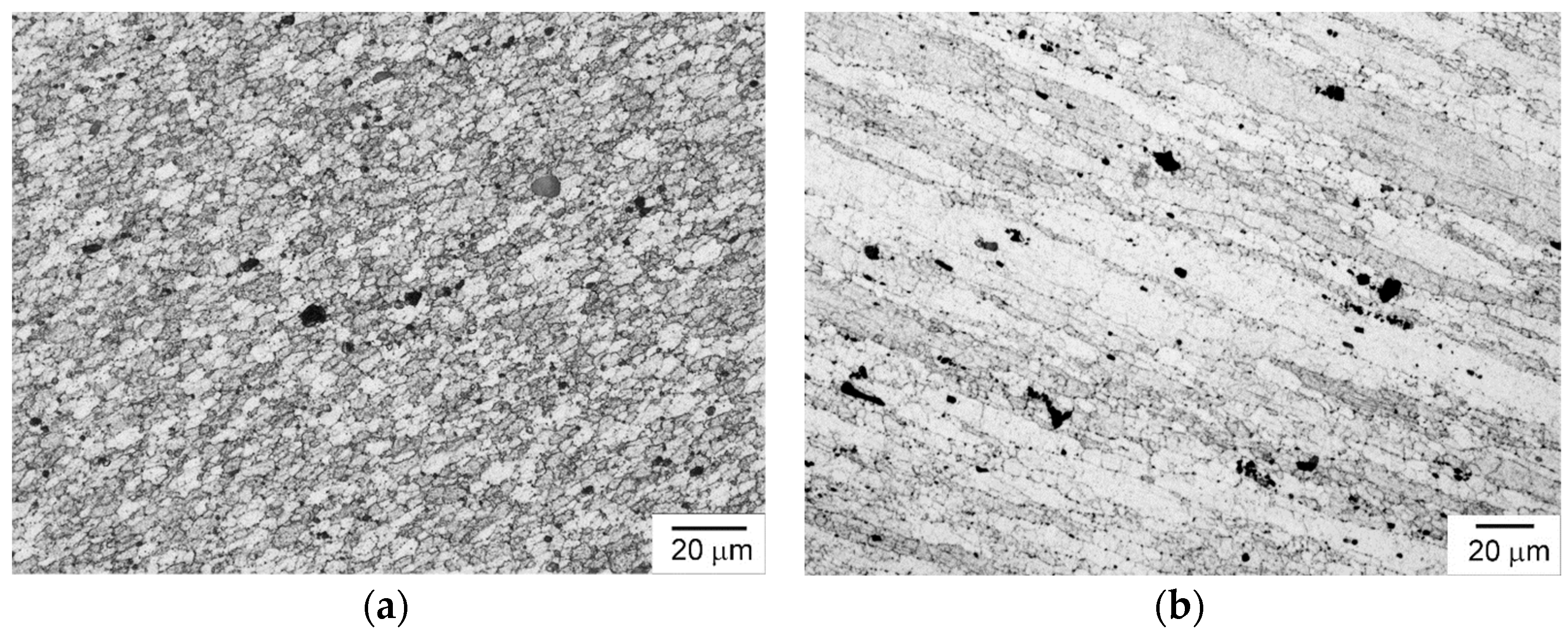
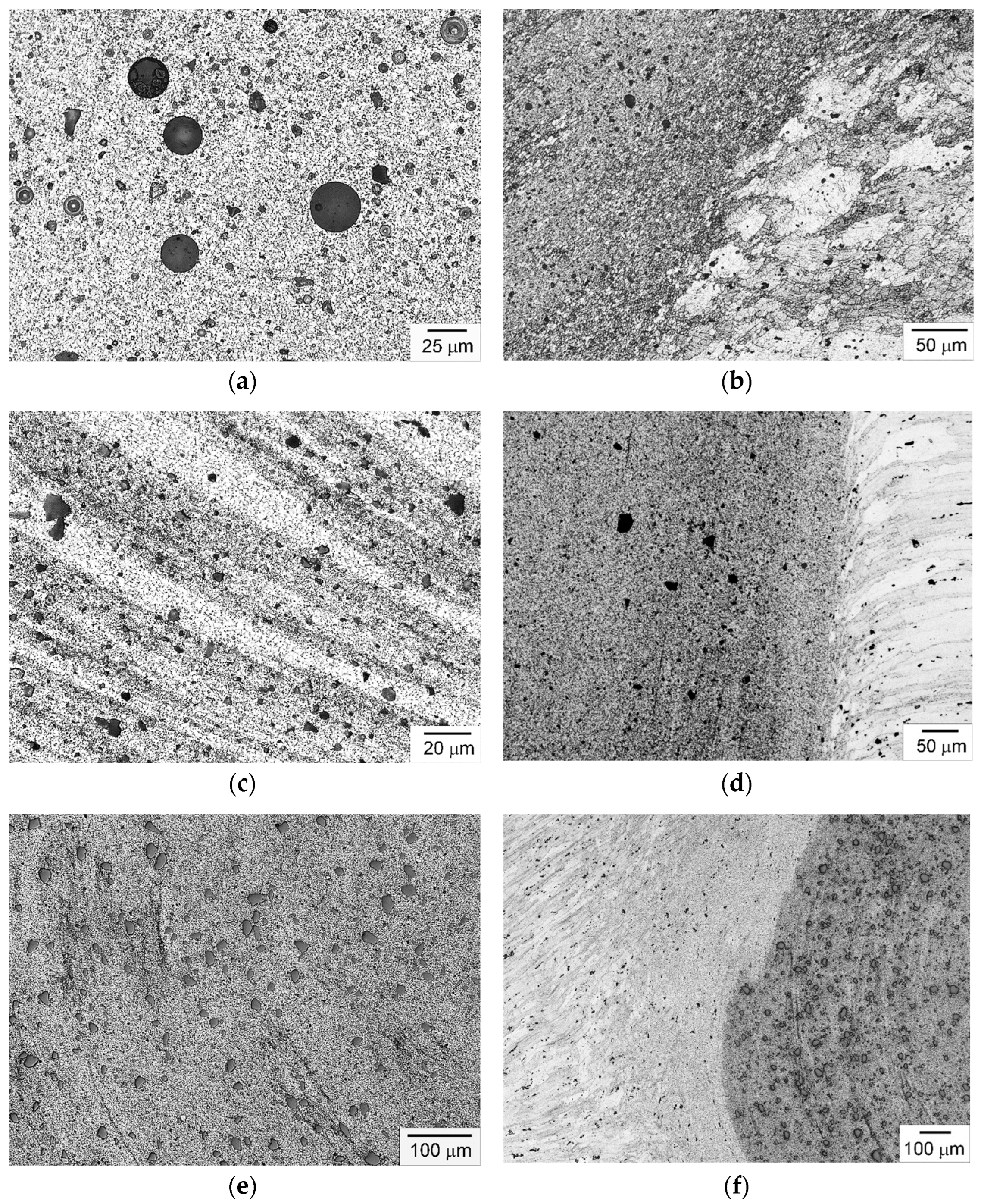
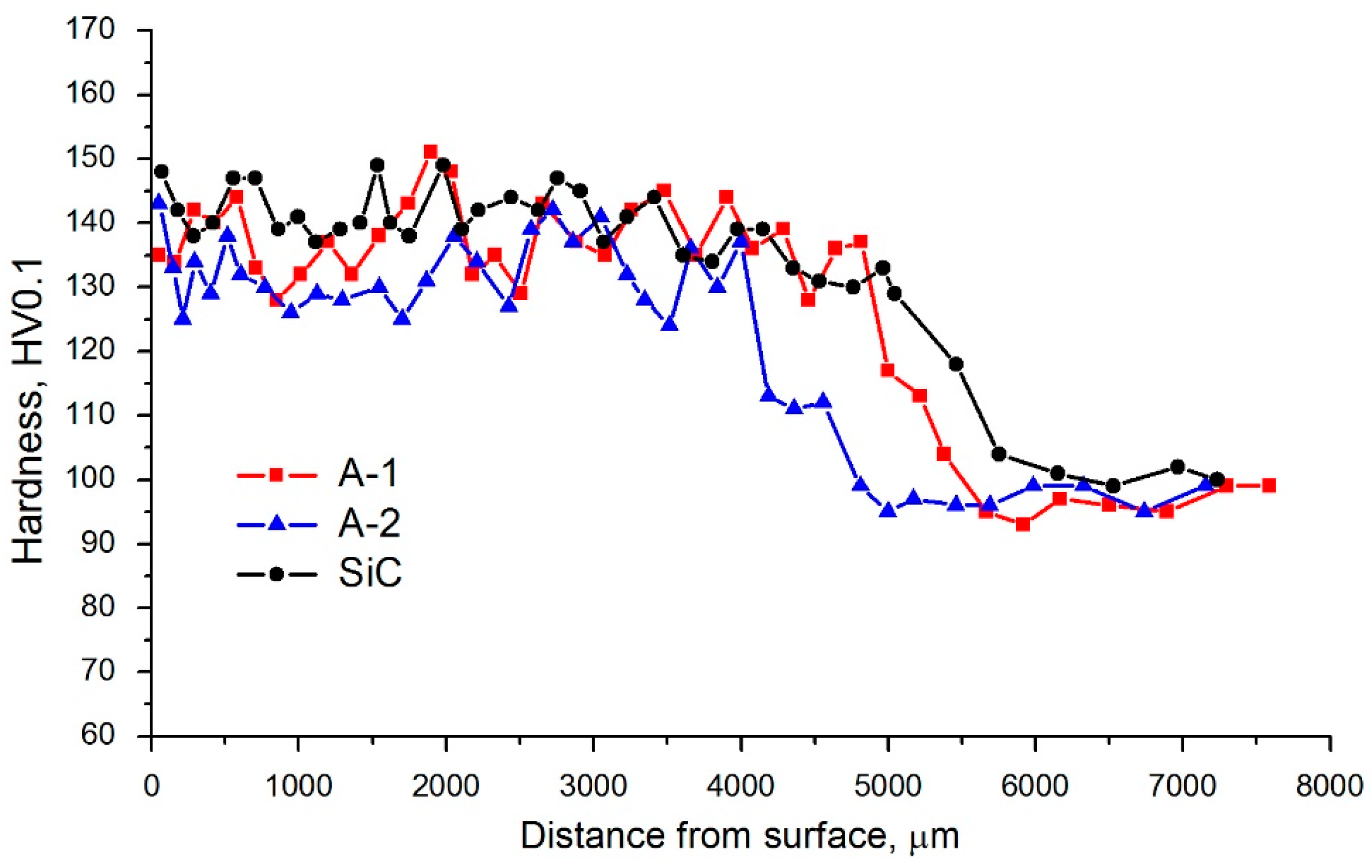

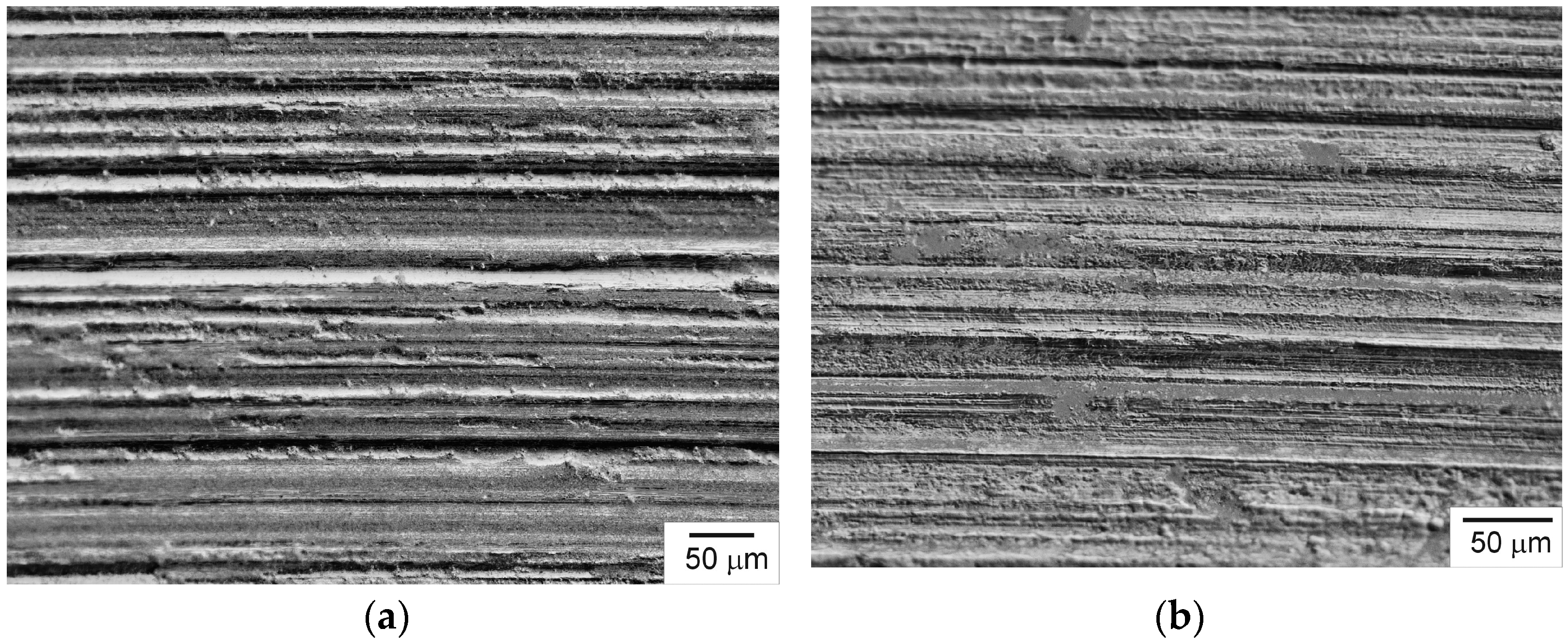
| Alloy | Element Content, wt% | ||||||||
|---|---|---|---|---|---|---|---|---|---|
| 7075 | Zn | Fe | Cu | Mn | Mg | Cr | Si | Ti | Al |
| 5.5 | 0.3 | 1.6 | 0.15 | 2.4 | 0.2 | 0.2 | 0.1 | 89.55 | |
| Ash | Element Content, wt% | ||||||||||
|---|---|---|---|---|---|---|---|---|---|---|---|
| SiO2 | Al2O3 | P2O5 | CaO | Fe2O3 | K2O | Na2O | MgO | TiO2 | SO3 | Other | |
| A-1 | 50.76 | 29.50 | 0.30 | 2.72 | 7.62 | 3.12 | 1.73 | 1.52 | 1.30 | 0.83 | 0.67 |
| A-2 | 60.47 | 17.89 | 2.22 | 6.74 | 3.65 | 0.88 | 0.88 | 1 | 0.75 | - | - |
| No. | Element Content, wt% | |||||||||
|---|---|---|---|---|---|---|---|---|---|---|
| C | O | Si | Al | Ca | Mg | Ti | Fe | Na | K | |
| 1 | - | 44.92 | 22.88 | 24.21 | - | - | 2.75 | 1.41 | 1.26 | 2.57 |
| 2 | - | 38.75 | 26.11 | 21.55 | - | 1.15 | 1.97 | 2.89 | 2.77 | 4.82 |
| 3 | - | 48.18 | 48.23 | 1.73 | - | - | - | - | 0.66 | 1.20 |
| 4 | - | 44.64 | 24.26 | 15.43 | 0.73 | 1.64 | 0.79 | 7.12 | 2.30 | 3.09 |
| 5 | 8.31 | 40.98 | 22.57 | 15.05 | 1.48 | 1.02 | 1.02 | 5.28 | 1.75 | 2.55 |
| No. | Element Content, wt% | |||||||||
|---|---|---|---|---|---|---|---|---|---|---|
| C | O | Si | Al | Ca | Mg | Ti | Fe | Na | K | |
| 1 | 67.40 | 23.89 | 2.47 | 2.78 | 1.83 | 0.29 | 0.53 | 0.81 | - | - |
| 2 | 13.27 | 44.16 | 42.25 | - | 0.31 | - | - | - | - | - |
| 3 | 81.61 | 13.33 | 2.30 | 1.45 | 0.71 | - | - | 0.33 | 0.28 | - |
| 4 | 45.41 | 34.84 | 10.81 | 4.63 | 2.43 | 0.21 | 0.37 | 1.15 | - | 0.16 |
Disclaimer/Publisher’s Note: The statements, opinions and data contained in all publications are solely those of the individual author(s) and contributor(s) and not of MDPI and/or the editor(s). MDPI and/or the editor(s) disclaim responsibility for any injury to people or property resulting from any ideas, methods, instructions or products referred to in the content. |
© 2024 by the authors. Licensee MDPI, Basel, Switzerland. This article is an open access article distributed under the terms and conditions of the Creative Commons Attribution (CC BY) license (https://creativecommons.org/licenses/by/4.0/).
Share and Cite
Iwaszko, J.; Kudła, K.; Sajdak, M. The Use of Ashes in Surface Metal Matrix Composites Produced by Friction Stir Processing. Appl. Sci. 2024, 14, 3544. https://doi.org/10.3390/app14093544
Iwaszko J, Kudła K, Sajdak M. The Use of Ashes in Surface Metal Matrix Composites Produced by Friction Stir Processing. Applied Sciences. 2024; 14(9):3544. https://doi.org/10.3390/app14093544
Chicago/Turabian StyleIwaszko, Józef, Krzysztof Kudła, and Marcin Sajdak. 2024. "The Use of Ashes in Surface Metal Matrix Composites Produced by Friction Stir Processing" Applied Sciences 14, no. 9: 3544. https://doi.org/10.3390/app14093544






